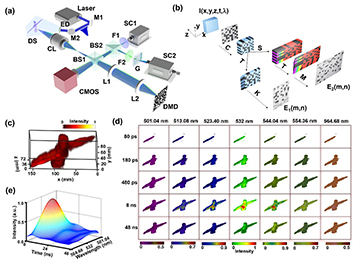
Artist view of five-dimensional imaging with temporal-spatial-spectral resolutions. [Image: S. Zhang, East China Normal University]
When capturing images of ultrafast phenomena, scientists often want simultaneous data from the temporal, spatial and spectral realms. Scanning imaging systems, however, have restricted frame rates that cannot capture changes that happen on picosecond or femtosecond timescales.
Now a research team in China has developed a snapshot imaging method that simultaneously acquires the three spatial dimensions along with the temporal and spectral dimensions (Adv. Photon., doi: 10.1117/1.AP.3.4.045001). Called spectral-volumetric compressed ultrafast photography, or SV-CUP, the technique captures images within an 8.8×6.3-mm field of view with 2-ps time frame intervals and 1.72-nm spectral frame intervals.
“We believe that the most important innovation in this work is the combination of compressive sensing, temporal-to-spatial information conversion and spectral-to-spatial information conversion in a single-shot imaging system,” says Dalong Qi, a physicist with the East China Normal University in Shanghai, China.
Improving the method
According to Qi, the idea of five-dimensional imaging is not new. Last year, OSA Fellow Lihong Wang and his colleagues at the California Institute of Technology, USA, developed a method for capturing ultrafast dynamics in the combination of 3D space, polarization and time. The East China Normal group’s 5D technique captures spectral information instead of polarization. “Therefore, we consider it a better way of performing the task,” Qi says.
The experiments involved a cross-shaped setup that included a pulsed laser, an engineered diffuser, beam splitters, a digital micromirror device, a CMOS camera and two streak cameras. Mathematically, the SV-CUP method combines two other techniques: hyperspectrally compressed ultrafast photography, which captures two spatial dimensions plus time and spectrum but has no spatial depth perception, and snapshot time-of-flight compressed ultrafast photography, which records data from all three spatial dimensions.
Schematic and 5D imaging using the spectral-volumetric compressed ultrafast photography (SV-CUP) technique. (a) Experimental system. (b) Schematic of operating principle. (c) Reconstructed data cube of 3D mannequin. (d) Selected reconstructed images of 3D mannequin at some representative times and wavelengths. (e) Time-resolved spectroscopy extracted from reconstruction data. [Image: P. Ding et al., Adv. Photon., doi: 10.1117/1.AP.3.4.045001 (2021)] [Enlarge image]
The biggest challenge, according to Qi, was corralling all the dimensional information together. The compressive sensing with the streak cameras and spectral dispersion – based on work done by the East China Normal group last year – took care of the spectral and temporal data, with the time-of-flight imaging equipment visualizing the target spatially. “By stamping the time sequence of two channels and developing corresponding image reconstruction algorithms, we could rebuild the 5D I(x, y, z, t, l) information of dynamic scenes,” he says.
To verify their proof of concept, the researchers viewed the photoluminescent dynamics of a 3D mannequin coated with cadmium selenide quantum dots. These dots require about 8 ns to reach their maximum fluorescence.
Biomedical applications
Qi hopes that SV-CUP will find applications in biology and medicine, although he cautions that the time-of-flight channel’s limited depth information will make it difficult to capture truly microscopic objects. Also, the repetition rate of the streak cameras limits the capture of depth variations at slow speeds.
Nonetheless, Qi says the technique, with further refinements, could be useful for 3D fluorescence lifetime imaging and investigations of ultrafast physical and biological phenomena.

